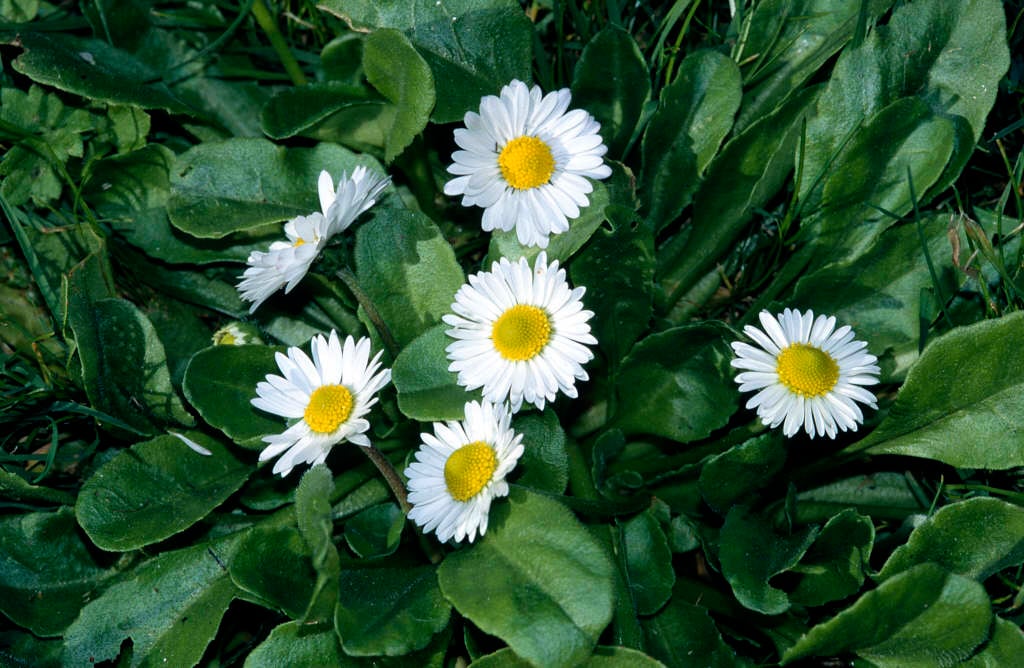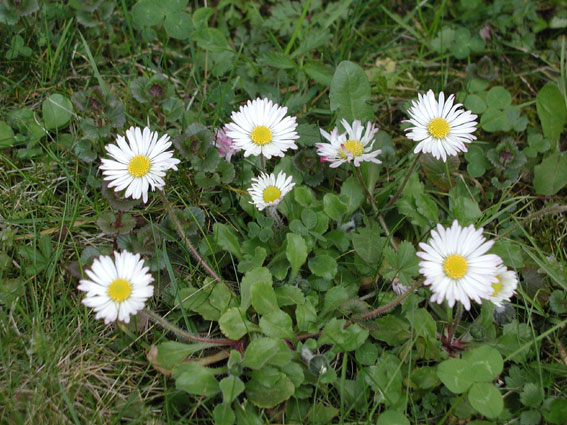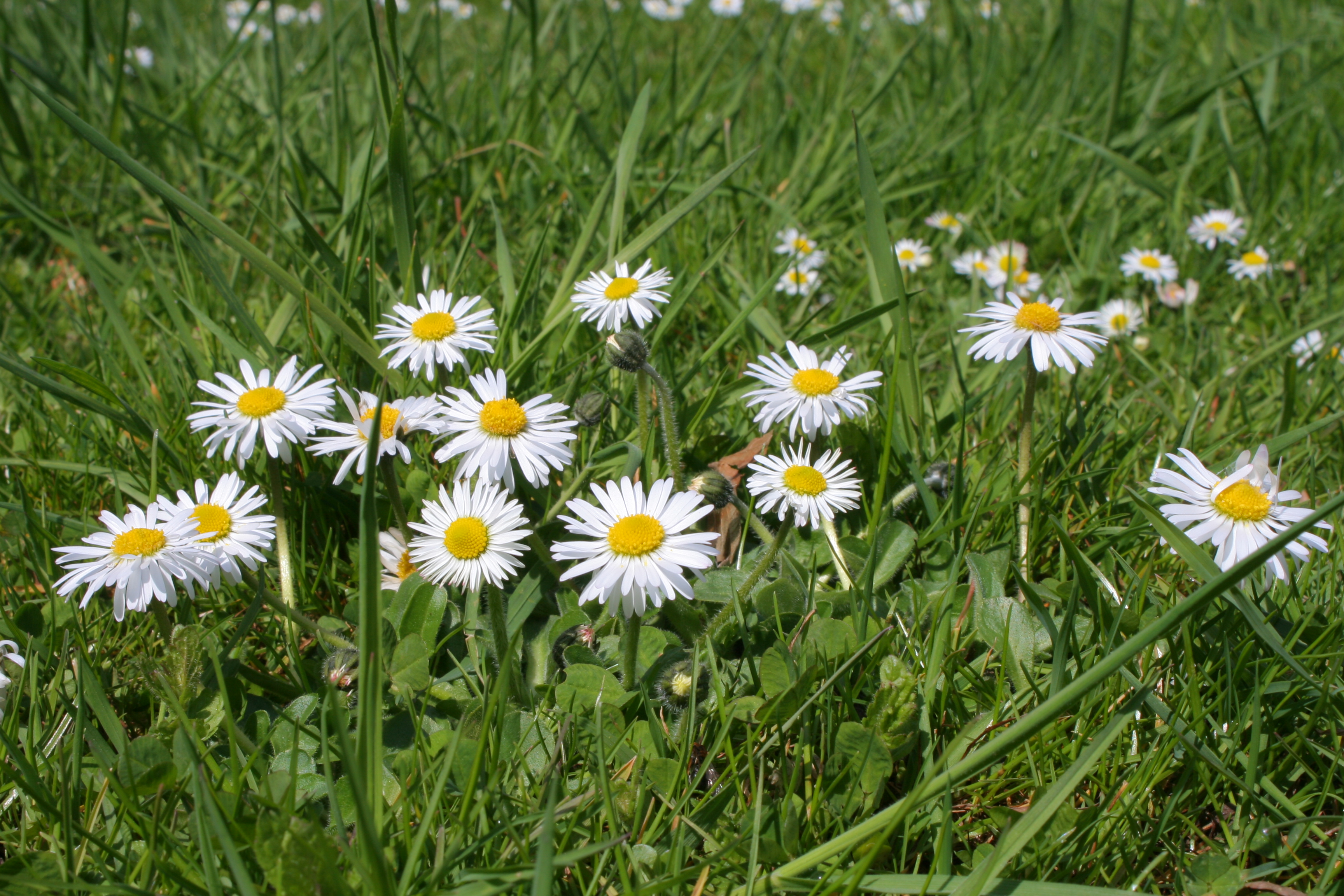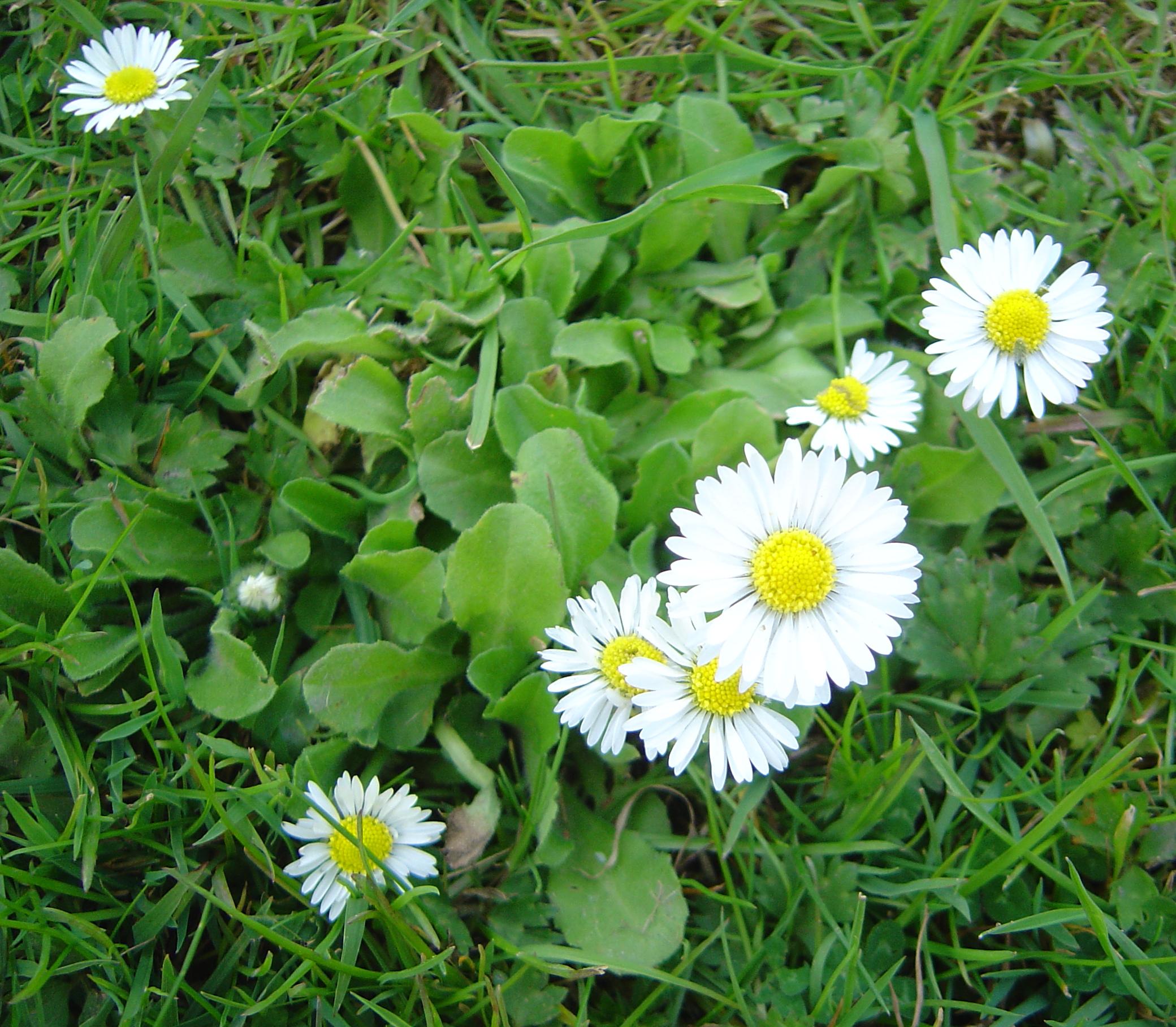Bellis perennis
Daisy (Bellis perennis)
The daisy (Bellis perennis), also called " Multi-annual Daisy ", daisies, daisies, Monatsröserl or Swiss Margritli called ( "Little Daisy " ), is a flowering plant in the sunflower family ( Asteraceae). As it grows on nearly every lawn, it is one of the best known plant species in Central Europe.
- 4.1 names
- 4.2 Use as a food plant
- 4.3 Historical Significance
- 4.4 Use as a medicinal plant
- 4.5 representations
- 4.6 superstition
Description
Vegetative characteristics
The daisy is a perennial, herbaceous plant that reaches the plant height usually 4 to 15 (2 to 20) centimeters. At the short, erect rhizome are fibrous roots.
The in a dense rosette of leaves standing together leaves are divided into petiole and leaf blade. The winged petiole at least as long as the leaf blade. The simple leaf blade has only one central vein, is spatulate to verkehrteiförmig shaped, 6-40 mm long and 4-20 mm wide.
Generative features
Each rosette brings from March to November uninterrupted ascending to erect, leafless, usually 5 to 15 (3 to 20) cm long Blütenstandsschäfte with solitary flower heads produced.
What looks like a single flower for a layman, is actually a fake flower ( Pseudanthium ). It is a basket- shaped inflorescence, consisting of more than one hundred individual flowers. The basket is directed due to the heliotropism always looking for the sun and closes at night and in bad weather. The flowers are - as is typical for Aster - on the enlarged stem axis, arranged the flowers stand-up so-called. The bracts have a ciliated border.
Constantly edge white, zygomorphic, female, 4-8 (up to 11 ) mm long tongue flowers are arranged in two rows. In the center of the flower Körbchens are 75-125 yellow, hermaphrodite and funnel-shaped radiärsymmetrische, 1.5 mm long tubular flowers. Two carpels are fused into one under constant, einfächrigen ovary.
The fruits are not equipped as those of some species of the daisy family with a pappus. In the 1 to 2 mm long achenes are crowned indehiscent fruits are grown together in the fruit and seed coat. The seeds are endospermlos.
The chromosome number is 2n = 18
Reproduction
The flower heads of Bellis perennis, which bloom from February through into November, are visited by bees, bumblebees, hoverflies and especially flies. Sometimes in the cross-pollination of these flower visits. Again, this helps to ensure a form of self- pollination, the so-called geitonogamy, ie the individual flowers within a flower head pollinate each other. The self-pollination within a single flower ( autogamy ) is questionable, however, not be entirely excluded. The flowers are typical for Daisy Family, vormännlich, that is, the stamens but mature pollen from when located in the prime carpels are not yet ready for pollination. In pollinated flowers from the ovary developed a nutlet, the so-called achene. The daisy uses a range of very different strategies for the spread of these achenes.
Typical of daisies is the spread of achenes through the rain. Thus, the achenes are thrown within the mother plant. Another form is spread by the wind instead of ( Anemochorie ). The elastic and slightly elongated stems are moved by gusts of wind and scattered small achenes. The achenes are also spread by animals ( Zoochorie ), especially by earthworms, sheep and cattle. Finally, even the man helps spread ( Anthropochorie ). The daisy multiplies by generative seeds ( achenes ) and vegetatively.
Occurrence
The genus of daisies consists of about 15 species, which have their main range in the Mediterranean. Only Bellis perennis can be found from this genre today in Central Europe and Northern Europe. Bellis perennis is considered a archaeophyte, who came through the creation of spacious meadows and pastures in prehistoric times to a wide spread northward. However, for such frequent occurrence of this plant, it only came with the introduction of lawns in gardens and parks. By the people, this type was later also in North and South America, along the Pacific coast, located in Madeira and New Zealand. Often, the spread is not done deliberately, but through contamination of grass seeds by the seed of the daisy -. Botanically this spread form is also called Speirochorie
Preferred locations are pastures, park lawns and gardens on nutrient- rich ground, overgrown railway embankments; a regular pruning is necessary because the grasses and wildflowers otherwise overgrow the low-growing daisies. Since Bellis perennis is a storage plant, it survives the winter in the snow. In agricultural fields, it is also pointers for compacted soils and used meadows and pastures.
Daisies and human
Name
This widespread species bears a number of popular names that can be regionally very different. Typical are Angerbleamerl, eyes flowers, Sky Flower, Flower of May, Marie flowers, daisies, Moonlight Flower, Morning Flower, Easter Flower, Rain Flower, summer roses, sun flowers and daisies. In Switzerland also: Gisegeisseli, Geissemeieli, Geisseblüemli, goats flowers, Mülerblüemli or Margrittli.
The term Maßliebchen is from the 14th century is as Maßleben, Maßlieben, Maßlieblin and probably borrowed from Middle Dutch matelieve into German.
Linnaeus knew that Daisy also appreciate Bellis (Latin ) for beautiful, pretty, perennis (Latin ) for persistent, perennial, he called this plant species.
Furthermore, there are or were for the plant species, some of them only regionally, the other German trivial name: Angeblümlein (Silesia, Swabia ), Anger flower ( Tübingen), Baumbüllichen, small leg waves ( Old High German ), Brink Blome ( Low German ), Buntblümlein ( Schwaben), Multi Colored Flower (Memmingen ), Chatzablüomli (Upper Rhine Valley, Untertoggenburg ) Dusendschön (Holstein, stuffed variant), Fentjeblöme ( Ostfriesland), Fenneblome (Ostfriesland ), White Frueblümlein (Silesia ), early flower ( Saxony, Gänsblümel ( Eichstädt ) Gänsblümlein (Silesia in Lauban, Glogau ), Gänsblümchen (Graubünden), Gaisblüomli (St. Gallen Rhine and Will Berg), Gänsegisseli ( Entlibuch ) Gänsegisserli ( Entlibuch ) Gartenbürstli (Luzern, Bern, filled variant), Gasbluoma (St. Gallen at Will hill), Gaseblaume (Göttingen), Geissblümli ( Zurich ), Geisgisseli ( Aargau ), gout weed, protruding flower ( Hesse, filled variant), Gönsekraut (Göttingen), grass flower, heart Blümle ( Henneberg, stuffed variant), Höppesli ( Schaffhausen, stuffed variant), Johannisblümli ( Grisons in Laas ) Käsblüomli (St. Bile in the Upper Rhine and Will Berg), Katte Blome ( Steding, Delmenhorst ), cherry flowers, Klawer Blömnik (Helgoland), Konrad Flower (Hall, filled variant), Konrädchen ( Hesse, filled variant), Love Blümle ( Henneberg, filled Variuante ) Maddelencesblümle (Eifel in Daun), Maddeseblümchen (Eifel near Altenahr ) Madlinblee, girls flower (Eifel in Dreis ) Märschblom ( Altmark), Magdalene floret (Eifel near Daun ), Magdelief (Hamburg), Magdlieben, Maiblome ( Butjaden filled variant), Maijenblome (Bremen ), Maisüsschen (Graubünden), Mali Escher (Eifel at Uelmen ), Maltevkes (Ostfriesland, stuffed variant), Maneablüamli (St. Gallen in Obertoggenburg ), Marga Rethel ( Schwaben), Margarethenklomel (Silesia ), Margarithesblume (Eifel at Gillespie field and Gerolstein ) Margenblaume (Göttingen, Osnabrück), Margritli (Bern), Marjen, Marie Blome ( Münster, lower Weser ), Marjenblome (Oldenburg, Osnabrück), Marienblomekens, Marienblömchen ( Westphalia, Thuringia, Helgoland), Marienblümlein (Schwaben ), Marie flower ( East Prussia, Pomerania, Hamburg ), Marie Bluemel (Silesia ), Marie coronet, Mark Blomen (Schleswig -Holstein), Marlblom (Mecklenburg, Schleswig -Holstein), Marlevkes (Ostfriesland, stuffed variant), Massblümlein, Masslibigen, Mass. loved ones, Masslieblein, Massüsselen ( Speyer ), Matze Lizzie (Nuremberg, Eifel ), Meargenbläumchen ( County of Mark ), Merginblum ( middle High German ), Miärgenblaume Halingen ) Mojleefkis ( Ostfriesland), Monale (Tirol ), Monatbleaml (Salzburg), Monatblüamli ( Glarus, St. Gallen, Graubünden, filled variant), Monatblümlein ( Augsburg ), month Blum (solid variant), Monaterle ( Augsburg), Monatlen (Tyrol near Brixen ), Moss Lieb, Mühleblümli ( Glarus ), Mühlebürstli ( Lucerne, filled variant), Mülinblümlin, garbage flowers, Mühliblüamli (St. Gallen, Grisons ), Müllerblüamli (St. Gallen, Graubünden, filled variant ), Easter Bluemel (Silesia ), Easter flowers, palm flowers, Ringelrösslein (Erzgebirge), Rockerl (Styria ), Ruckerl (Styria ), Sametblümli ( Lucerne, filled Vareiante ) Schweizgerlar (Ziller Valley), Summer Rösslin (Erzgebirge), Sommerthierlein (Silesia ), thousand Schin Chernobyl ( Transylvania, stuffed version), daisies ( Lucerne, filled variant), convertible land (Saxony), Wasenblümli ( Lucerne), Wiesali (St. Gallen Sargans ), winter crown, Zeitlösslin ( Westrich ), Timeless (Graubünden) and Zytlosenkrut.
Use as a food plant
The daisy is sometimes used as a forage crop. It can also be used in the salad. The best way to taste the young leaves from inside the rosette. The flowers are edible. The buds and the only half- opened flowers taste pleasantly nutty, slightly bitter contrast, the open flowers, which makes them suitable primarily as a salad addition. Buds are sour pickled sometimes used as a substitute for capers.
Historical Significance
Pliny the Elder mentioned the daisy in his Naturalis historia ( Volume 26, § 26): " The daisy ( bellis ) grows in the meadows and has a white, slightly reddish continuous bloom. Launched with Artemisia, it should be of greater impact. "
In an Alsatian manuscript from the first quarter of the 15th century, the daisies " Citelosen " was called: " Citelosen is water from the Krute gebrant getruncken the sore heals lute well VND VND dz verserte gederme maketh soft in the libe. " In Elixir Nicholas ... Frauenlobstraße the daisy as " Allermaneyd plue " ( Allermonats flower) was called. Frauenlobstraße writes him to 11 virtues: first as an ointment prepared for scaly facial skin. 2 As a salve against " sprinczel " ( freckles ). 3 As a decoction drunk for coughs, especially in children. 4 With ox bile as an ointment prepared against " swarcz blemish on the countenance " ( age spots? ). 5 The decoction of the herb drank for stool excretion or the root eaten to stimulate the Harnaustreibung. 6 Often eaten against " luxuria " ( lust, gluttony ... ) 7 The juice or hot cooked plant as a support for " crazed gliders " ( dislocations ). 8 The crushed plant with the juice as a support for broken bones. 9 The crushed root as a support in comminuted fractures ( " attracteth dy zebrochen pain herauss "). 10 Together with " lactuca " (garden salad) ate effective against many diseases. 11 The seeds boiled in wine drinking against all " Schedlich sleg vein würff ".
The published in Mainz in 1485 Gart health was the daisy faithfully from the chapter 333 ( " Premula veris maßlieben "). Hieronymus Brunschwig called The Daisy " Consolida minor" and had therefore refer to its wound-healing effect. The "Fathers of Botany " Jerome Bock and Leonhard Fuchs ( Ch. 53) lined up the daisies in the section " Consolida minor". Bock moved yet, as Brunschwig, the forest - Sanikel in this category.
In his published in 1539, not illustrated herb book Hieronymus Bock described the daisy so impressively that a picture was unnecessary:
- " The Maßlieben auff the awen VND feüchten graß gardens / the jnwendig ... geele eyes have such Chamillen / and Wherefore Kleynen with white or with rotleibfarben bletlin adorned VND bekleydet. This blümlin you find almost through gantz jar / but against the früling on meysten. Are Stöcklin wurtzeln with wasichten filtzichten or zasichten white / how wurtzeln the plantain. The herb schweitzer green Lynd vnnd weych. Jn the first before it kindles to blüen / it is auff the ground gespreyt / anzůsehen as eyn beautiful star. However, this herb eyn little then breytter dz gemeyn Meüß örlin ( = small hawkweed ). StOSt for the first green knöpflin as flax bollen / rising auff thin round Stengelin Overvie span high or less / and tuna to auff to flowers / which they are zeittig / felt the geel it ( Welch's is the seed ) Auss / and pflantzt be perso / how the farmland Chamillen. "
Use as a medicinal plant
The tubular flowers contain the saponin Bayogenin, essential oils, bitter principles, tannins and mucilage. It was also in the flowers, as in many Asteraceae, which demonstrated apigenin 7 - glucoside Cosmosiin. In recent studies of Bellis perennis antimicrobial and antihyperlipidemic effects could be demonstrated.
Daisy flowers are volksheilkundlich used as a remedy for skin diseases, painful or absence of menstruation, headaches, dizziness and insomnia. Also for cough solution daisy is applied, which is due primarily to the content of saponins. An effectiveness in this application has not been documented. As tea-drug the flowers of the daisy (Flores Bellidis ) are used for the homeopathic use of a tincture of the fresh plant won.
Representations
Royal Tombs of Ur from the third millennium contained a golden headdress, decorated with daisies. A very old 16 -leaved form of the daisy is found as abundant element on the Ishtar Gate, a character Istar.
The daisy came to unimaginable fame when it by the French king Louis IX. (1214-1270) was recorded together with the lily in his coat of arms. To this end, he allowed himself to make a ring with a braided flower wreath.
Superstition
The daisy is one of the first signs of spring, and it is, who eat the first three daisies in spring, will spare the rest of the year from a toothache, eye discomfort and fever. And who is dried daisies with him, which were picked at noon on Midsummer between 12 and 13 clock, the important work is not wrong.
Use finds the daisies as well as an oracle by the individual petals of a flower connected with alternating rhymes (such as: ... loves me, loves me not, loves me ...) are plucked.
Photos
Detail Daisy inflorescence.
Red flowering cultivar ' Rob Roy '.
Detail cultivar ' Rob Roy '.
Detail of a cultivar with red-rimmed ray florets.
The whole plant with roots.


.jpg)






